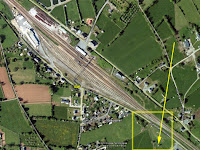At the beginning of March I was collected at Ouistreham docks by a friend and we motored via as many of the country lanes to Dieppe. A lovely drive through pre-spring countryside.The weather though was not as nice as we would have liked.
Dieppe was targeted by a combined British and Canadian force in 1942 as a test to see how hard or easy it was to attack a fortified enemy port. If it had been successful the Canadians would have landed, fought and returned to their landing craft and sailed back to Newhaven, where they had started. Well as you may know it all went very wrong. After 1942 and the German attack on Russia, Hitler could not afford the troops to fight in Russia and cover an elongated front from line from Norway to the Spanish border.
This brings me back to our trip.
We started at Wn Die02 which covers the east side of the cliff top
Die03 La Pollet the under cliff with bunkers for machine gun and Skoda 4.7cm fortress guns.
Next was Die06 the opposite cliff covering from the old castle 'Chateau de Dieppe' with several fire control posts still accessible.
We continued on in deteriorating weather to Die08, 10 & Die11 a massive bunker site called 'Dickhouter' with a large radar bunker and loads of defence bunkers.

























 ft
ft


















